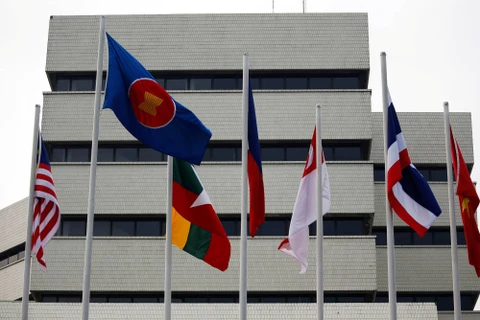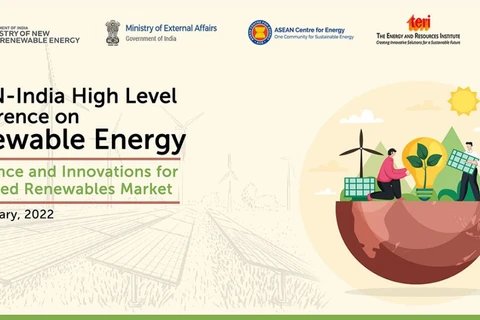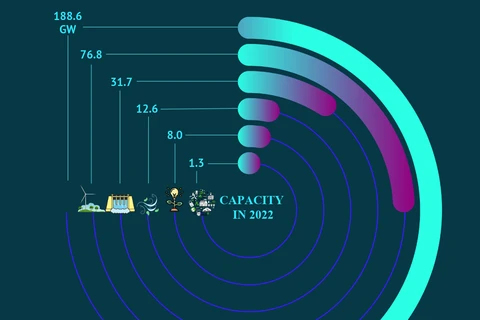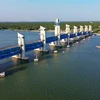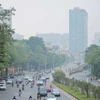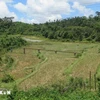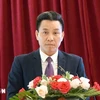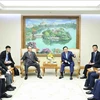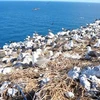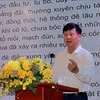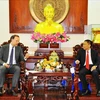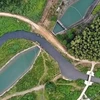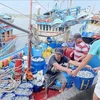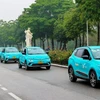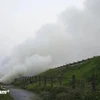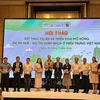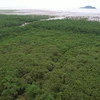 Tang The Cuong, Director General of the Department of Climate Change, speaks at the webinar. (Photo: VNA)
Tang The Cuong, Director General of the Department of Climate Change, speaks at the webinar. (Photo: VNA) Speaking at the webinar, Pana Janviroj, Executive Director of the ANN, who moderated the event, said: "[Renewable energy] is the topic that we will keep going back to in Asia in the near future.
"It’s a growth area that has a big impact on climate change, but many issues remain including consumers being confident in adapting to solar energy."
Harald Link, Chairman of B. Grimm Power Pel based in Thailand, said the wide development of clean energy spurs innovation and this offers many insights and models for Asian countries to consider.
“Renewable energy is really the new norm now. Wherever you go, everybody's interested in renewable energy and in the different forms, whether it's wind, water, sun, biofuels, and even waves.”
“There are a lot of innovations happening nowadays so we can look at the peer-to-peer renewable energy in various countries in Europe.”
“The development of renewable energy needs good regulations. It is important to organise an ecosystem of renewable energy sales,” he said, noting mechanisms such as FiT and Power Purchase Agreements (PPAs).
Link is hopeful about the prospect of renewable energy development.
There is a huge ecosystem for renewable energy already in the world and there will be more.
“There are huge opportunities for renewable energy and it will continue for the next few decades,” Link said.
"Energy trading is prevalent in Thailand, which allows us to join wider networks and transmit power from one country to another and get connected," he added.
“The sky is the limit. Every country may have their own way of doing and it is good that we can learn from many others,” he said.
Frank Phuan, CEO of SUNSEAP Group Pte company based in Singapore, also shared insights about renewable energy development in Singapore.
Noting that more than 95 percent of Singapore's electricity is powered by natural gas, Phuan said the country’s zero-emission target is an ambitious one given that it is a small country.
“It has to depend on technology and policy as well as work with neighouring countries to allow zero-emissions to happen,” he said.
Due to land constraints, solar PV systems have been installed on rooftops all over the country as well as on water, Phuan said, noting that 50 percent of government buildings are covered by solar panels.
The government also allows clean energy piped into Singapore, allowing the import of up to 4GW of low-carbon electricity by 2035.
Phuan said he has witnessed both good and bad trends in clean energy development in the region, adding that “good is more than bad”.
“There is a trend of large-scale hybrid solar and battery combination,” he said.
The gigawatt-scale projects spur the development of all forms of battery, and more development will come in the form of long-duration of power storage, he said.
He noted that there are many opportunities looking at these large-scale hybrid solar projects.
He emphasised the development of floating solar in hydro dams as well as the implementation of solar-integrated agriculture, notably in China and Taiwan.
Phuan highlighted the need to strengthen the private and government partnership as well as measures to tackle distribution capacity issues.
Meanwhile, Anil Sood, President of India’s Chetna, expressed his concerns about the economic impacts of overloaded transmission networks and environmental consequences if a large number of batteries are not treated properly.
"While we go for green energy, it is important not to lose sight of how to solve shelf-life problems," he said.
An overview of the webinar "Asia: Renewable Energy Continent."
Vietnam's efforts acclaimed
Hideki Minamikawa, President of the Japan Environmental Sanitation Center, and former Vice Minister of the Environment, highlighted Vietnam’s commitments to achieve zero emissions by 2050, shared experience from Japan and stressed the cooperation between the two countries in renewable energy.
“The Vietnamese Government's efforts to address climate change have received international acclaim,” he said.
To achieve virtually zero emissions by 2050, Minamikawa said, Vietnam will take strong measures to reduce emissions by taking advantage of its strengths in the renewable energy sector.
Sharing the Japanese approach to clean energy, Minamikawa said Japan's commitment to renewable energy began in 1974, triggered by the first oil crisis that occurred the previous year.
The country has had a number of policies to increase energy from clean sources including those from solar, wind, hydrogen and biomass.
However, Japan's current renewable energy development is not sufficient and there are challenges with regard to the power grid.
He said the biggest bottleneck is the inadequate deployment of transmission lines from areas with large amounts of renewable energy generation potential to large consumption areas, and the costs are borne by the power producers, not the power companies.
Still, renewable energy is the backbone of power generation in Japan, he said, noting that it is expected to provide up to 38 percent of Japan's total power generation in 2030.
He noted that the Japanese government is supporting the development of renewable energy overseas as a measure to combat global warming.
Japan has been promoting environmental cooperation in Vietnam, including cooperation in the development of renewable energy, through a memorandum of understanding signed in 2013.
He recalled that in 2020 the two countries agreed to further cooperate in promoting a decarbonisation transition and in combating plastic marine pollution.
“In this context, the development of renewable energy is the most important subject, and I look forward to its further enhancement,” he said./.
VNA

